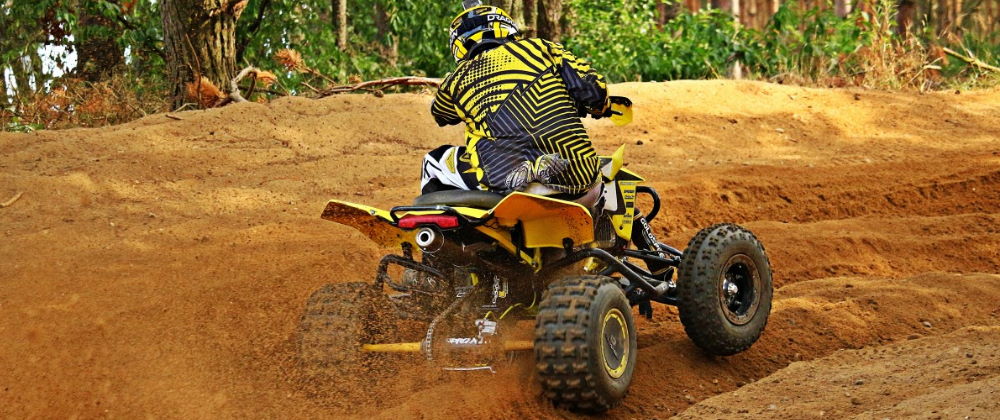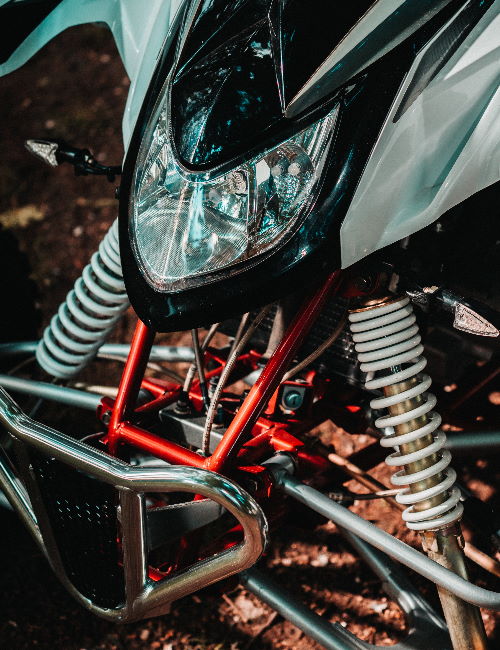UNDERSTANDING THE SUSPENSION OF YOUR QUAD
The role of suspension
The role of the suspension is to improve handling. To do this, it presses the wheels to the ground. The suspension consists of springs.
ATV's suspension is essentially made up of shock absorbers. The quad’s shock absorber is a part whose role is to attenuate the violence of shocks. Like a sponge, the shock absorber must absorb the irregularities of the ground. Thanks to the springs, it stores the energy produced. Par therefore, the pilot feels the oscillations only weakly.
Without damping, your quad would jump from bump to bump. Damping consists of slowing down movements.
The suspension consists of a connecting device between the "unsprung masses" and the "sprung masses", a spring and a shock absorber.
It's the spring that suspends you in the air, preventing your quad from collapsing on its stops. The spring is usually metallic and helical.
Metal springs are made of steel and very rarely titanium, which is lighter, but very expensive!
The spring is often linear, ie of constant stiffness. This means that from the beginning to the end of its travel, it offers the same resistance for the same depression.
On the other hand, a progressive spring will react at the start of the stroke, and will increase the resistance at the end of the stroke allowing for a flexible suspension. This progressiveness can also be obtained byar the reduction of the suspension itself (system of rocker/rods, also linear or not).
The different types of shock absorbers and suspensions
1: Emulsion Damper
The body is not completely filled with oil. A pocket of pressurized gas is naturally maintained above the oil level to compensate for variations in volume due to heating.
2: “De Carbon” type shock absorber. Process under De Carbon patent
Oil and gas are separatedar a floating piston. The gas pressure can be increased, making it possible to maintain a much higher consistency during heating. This assembly is the most widespread in all car and motorcycle production.
3: "De Carbon" type shock absorber with external reservoir
This is the same operating principle as the previous one, but with an attached tank allowing the volume of oil to be increased. This always with a view to controlling temperature variations.
4: "De Carbon" type shock absorber with separate external reservoir
Same, with separate tank required for certain assemblies.
5: MacPherson-type suspension
Engineer Earle S. MacPherson (1891-1960) had the idea of combining the vertical travel movements of the suspension and the rotation of the front wheels in a single device ensuring par elsewhere the damping of the suspension. This very simple system generally makes it possible to reconcile the significant deflections of a suspension with the reduced location left par a front transverse engine.
It consists of a single transverse suspension arm (or wishbone in the so-called "pseudo McPherson" type) par side. The junction between the suspended and unsprung masses is made.ar a ball joint on the wheel side and a cup on the chassis side. The shock and coil spring are concentric on the strut — called the strut force — Rigidly attached to the steering knuckle. The anti-roll bar ensures the longitudinal guidance of the transverse arm.
6: Double wishbone type suspension
The double wishbone suspension is of the independent type: the left axle suspension is independent of the right axle suspension (and vice versa). As its name suggests, the double wishbone suspension is characterized byar two triangles, which can be of different sizes. These two triangles are connected to the wheel par the rocket carrier.
It's worth noting that even Formula Ones use the double-wishbone suspension.
![]()
Operation and settings
1: The piston and its role as a hydraulic brake
Placed on the rod of the shock absorber, it slides in the body of the latter. Its displacement forces the oil to pass through its orifices. These are partly obstructedar the clappers. Their pyramidal stacking imposes a certain flexibility on them, thus making it possible to vary the flow according to the speed of displacement of the piston. It is by playing on this stacking that the behavior of a shock absorber is shaped. In pro language, we talk about setting. A shock absorber preparation consists of a choice of setting different from the origin.
2: External compression/rebound settings
A shock absorber dedicated to performance offers you to refine the hydraulic circuits from the outside via knobs. Acting in parallel with the main circuits, they adjust the passage sections of the well/needle combinations that make them up. Concerning the compression, a double system (managing high and low speeds) makes it possible to refine the development even more. Indeed, the shocks to be absorbed are not all of the same order. The firmness desired during a big acceleration in support is totally different from that necessary to withstand a violent shock (par example provoked par an irregularity such as a speed bump, vibrator or other).
There are also "independent wheel" suspensions in which on the same axle the left part is separated from the right part, "rigid axle" suspensions where the left and right parts are related.

Adjusting the suspensions
Starting at 550cc, almost all quads come with adjustable shocks.
- Basic principles. Avoid notch settingsar notch (we don't feel the difference). The softer the spring, the more it will need to be compressed to get the correct preload length. A loose spring will be an advantage when braking, but harmful when accelerating (crushing).
1°) The spring preload: it is used to compress the outer spring for two different uses. The first is to stabilize the height of the machine by adjusting a preload which balances the front weight of the machine with the reaction effort. The second is to pre-harden the spring before shocks during jumps (on all shock absorbers, even the bad ones). It is possible according to the manufacturers to have the springs adapted according to the machine, the use (training, competition) and the weight of the pilot.
2°) The hardness: adjustable with a small wheel. This is used to harden the shock absorber during shocks. Too flexible, the machine hits the front, too hard, we take everything in the arms and the body, the quad giving the impression of being a Kart. Finding the right compromise is quite difficult.
3°) The Rebound: Adjustable usually at the base of the shock shaft. During shocks or jumps, the shock absorber compresses. Under the combined effect of the spring and the compressed gases, it tends to relax suddenly, causing a rebound effect at the front and rear of a "racket". To reduce this effect, you have to slow down the "relaxation", the purpose of this setting. There also the good compromise is not obvious to find. Too much rebound and the quad bounces around, too little and the shocks don't have time to reposition themselves before the next bump and the quad slaps.
- Some adjustments (starting from your original configuration)
In the mud, you have to harden the compression and re-tighten the spring (reduce the preload) to compensate for the weight of the mud.
In the sand, you have to harden to avoid sinking. Brake the hydraulics in compression and keep the standard rebound setting.
In the dry and on broken ground and if the wheel hits hard and does not absorb the holes, you must soften it by slightly unscrewing the compression and the rebound, you must also reduce the prestress. In extreme cases, you can completely unscrew the compression screws at the front (keep a margin of 2 notches).
As for the adjustment of the stock shocks: in 99% of cases, the fronts are only adjustable at the level of spring compression. Only the rear shock has additional settings such as rebound or hardness.
Learn more about quad suspensions
Why prepare your suspensions?
Originally, the suspensions which leave the factory following the specifications of the manufacturers, have a standard basic operation.
Preparation is an essential step to improve their performance. The preparation of the suspensions is carried out according to your level of piloting, your weight, the practiced discipline. For competition or for leisure, to each his preparation of suspensions.
What are the benefits for my quad?
Preparing the suspensions is the guarantee of obtaining better safety and better control of your machine.
More comfort, more traction, no bottoming out on jumps, less steering at high speed, no more arm pain...
OUR ADVICE : To keep all the efficiency of the work done on your suspensions and avoid premature wear, do an oil change 2 to 3 times par
























